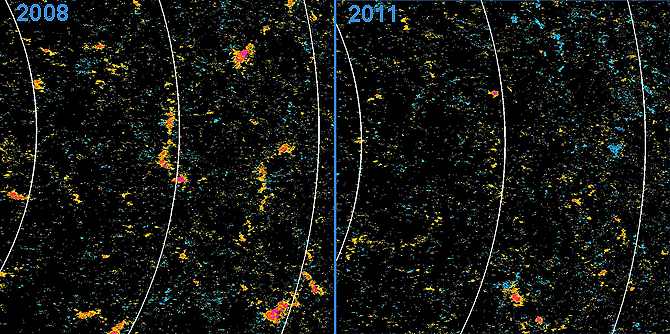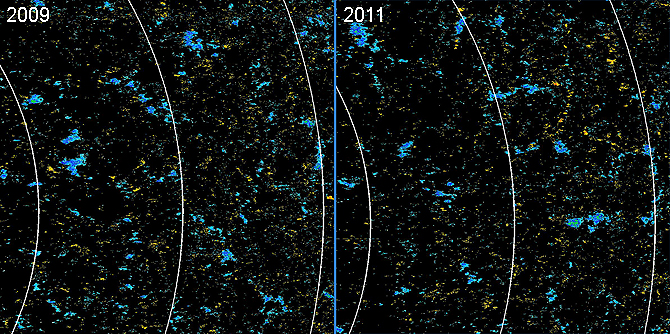Approximately every 11 years, the magnetic field on the Sun reverses completely – the north magnetic pole switches to south, and vice versa. It’s as if a bar magnet slowly lost its magnetic field and regained it in the opposite direction, so the positive side becomes the negative side. But, of course, the Sun is not a simple bar magnet and the causes of the switch, not to mention the complex tracery of moving magnetic fields throughout the eleven-year cycle, are not easy to map out.
Mapping such fields, however, is a crucial part of understanding how – and, in turn, when – the Sun will exercise its next flip. This flip coincides with the greatest solar activity seen on the Sun in any given cycle, known as “solar maximum.”
While the cycle unfolds with seeming regularity every 11 years, in two upcoming papers, scientists highlight just how asymmetrical this process actually is. Currently the polarity at the north of the Sun appears to have decreased close to zero – that is, it seems to be well into its polar flip from magnetic north to south – but the polarity at the south is only just beginning to decrease.
“Right now, there’s an imbalance between the north and the south poles,” says Jonathan Cirtain, a space scientist at NASA’s Marshall Space Flight Center in Huntsville, Ala., who is also NASA’s project scientist for a Japanese solar mission called Hinode. “The north is already in transition, well ahead of the south pole, and we don’t understand why.”
One of the two papers relies on Hinode data that shows direct observations of this polar switch. The other paper makes use of a new technique observing microwave radiation from the Sun’s polar atmosphere to infer the magnetic activity on the surface. The asymmetry described in the papers belies models of the Sun that assume that the Sun’s north and south polarities switch at the same time. In addition, both papers agree that the switch is imminent at the north pole, well in advance of general predictions that solar maximum for this cycle will occur in 2013. Lastly, the direct Hinode results also suggest a need to re-examine certain other solar models as well.
Measuring the magnetic activity near the poles isn’t easy, because all of our solar telescopes view the Sun approximately at its equator, offering only an oblique view of the poles, when they require a top-down view for accurate magnetic measurements. Hinode can observe this activity annually with its high resolution Solar Optical Telescope that can map magnetic fields when observing them from near the equator. The microwave radiation technique described in the second paper makes use of the discovery in 2003 that as the Sun moves toward solar maximum, giant eruptions on the sun, called prominence eruptions – which during solar minimum, are concentrated at lower solar latitudes – begin to travel toward higher latitudes near the poles. In addition, the polar brightness in the microwave wavelengths declines to very low values.
“These prominence eruptions are associated with increased solar activity such as coronal mass ejections or CMEs, so CMEs originating from higher latitudes also point to an oncoming solar maximum,” says Nat Gopalswamy. Gopalswamy is a solar scientist at NASA’s Goddard Space Flight Center in Greenbelt, Md., and is the first author on the microwave observations paper, which was accepted by The Astrophysical Journal on April 11, 2012. “When we start to see prominence eruptions above 60 degrees latitude on the Sun, then we know that we are reaching solar maximum.”
To look at the prominence eruptions toward the poles, Gopalswamy and his team used observations from Japan’s Nobeyama Solar Radio Observatory telescopes and the joint ESA/NASA mission the Solar Heliospheric Observatory (SOHO). They watched the Sun in the microwave wavelengths – which are used to observe the area of the Sun’s atmosphere just above the surface, known as the chromosphere. Gopalswamy created precise techniques to use such microwave radiation to measure the intensity of magnetic activity on the Sun’s surface at the poles. By mapping the brightness of the microwave radiation throughout the chromosphere, the scientists showed the intensity at the north pole has already dropped to the threshold that was reached in the last solar maximum cycle, suggesting the onset of solar max there. This is backed by the fact that prominence eruptions are also occurring at high latitudes in the north. Eruption activity in the southern half of the Sun, however, is only just beginning to increase – the first CME occurred there in early March 2012.
The Hinode data also shows this discrepancy between the north and the south. The Hinode results are reported by a Japanese team, led by Daikou Shiota, a solar scientist at RIKEN Institute of Physics and Chemical Research, and were recently submitted to The Astrophysical Journal for publication. Shiota and his team used Hinode to observe the magnetic map of the poles every month since September 2008. Early maps showed large, strong concentrations of magnetic fields that are almost all magnetically negative in polarity. Recent maps, however, show a different picture. Not only are the patches of magnetism smaller and weaker, but now there is a great deal of positive polarity visible as well. What once pointed to a strongly negative north pole, is now a weakly magnetized, mixed pole that will become neutral – which occurs at solar maximum – within the month, according to the team’s predictions.
“This is the first direct observation of this field reversal,” said Cirtain. “And it is extremely important to understanding how the Sun’s magnetism generates the solar cycle.”
Ted Tarbell is the principal investigator for Hinode’s Solar Optical Telescope at Lockheed Martin in Palo Alto, Calif., and he points out that the direct measurements showed the progress of the pole reversal and highlights the earlier portion of the cycle in 2008. Typical models of the magnetic flip suggest that as active regions rotate around the equator, their higher, trailing edge – which is almost always the opposite polarity from the pole in their hemisphere – drift upward, eventually dominating the status quo and turning positive to negative or negative to positive. The Hinode data show that this transition at the north began before such drifting had a chance to occur.
“This is one of the most interesting things in this Hinode paper to me,” said Tarbell. “How did the polar reversal start so early, even though the onset of the solar cycle, that is, increased activity at lower latitudes, hadn’t begun yet?”
Tarbell thinks these observations mean that this model, too, may need to be re-examined.
Such adjustments to models are of course expected whenever new and better data is collected. Indeed, David Hathaway, who is a solar scientist at NASA’s Marshall and a co-author on the microwave observations paper with Gopalswamy, pointed out that the idea that asymmetries exist in the Sun is not completely new. Other work has recently emphasized symptoms of this asymmetry, measuring, for example, more sunspots in the northern hemisphere than in the south at the moment. “But most of the well-developed models don’t incorporate the asymmetry in them,” Hathaway said. “More complicated models that incorporate asymmetries do exist, but they have other ways in which they fail to match observations.”
Continued study on these differences, using the best observatories as well as new techniques for analysis will help expand and improve our understanding of the sun, its 11-year cycle, and the great eruptions that occur on its surface.
Scientists will also keep their eye on the current cycle – numbered Solar Cycle 24 – because a polar switch at the north that is sooner than was expected also implies this may be a fairly small cycle in terms of the number of sunspots and amount of solar activity.
Related Links:




























